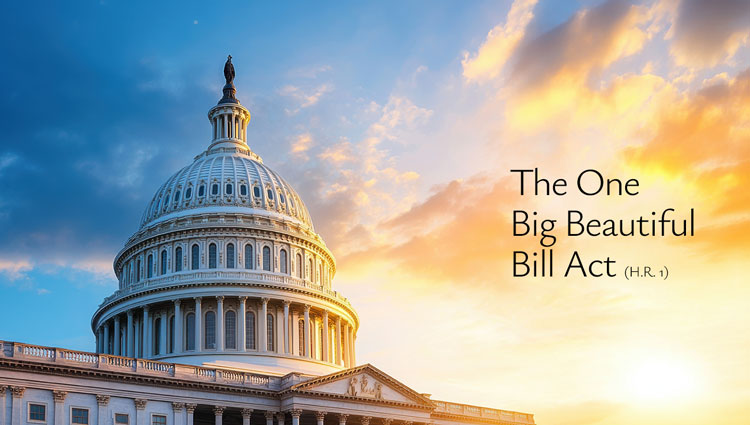
UPDATED NOVEMBER 4, 2025
Note: This summary reflects our best understanding as of November 2025 and will very likely evolve as Treasury issues implementing regulations. Always consult a tax professional or legal advisor before acting on these provisions.
On July 4, 2025, the One Big Beautiful Bill Act (OBBBA) became law, reshaping several rules that affect charitable giving. Below is a donor-friendly summary and practical planning pointers.
Starting with 2026 tax returns, taxpayers who do not itemize may deduct cash gifts to qualified public charities up to:
Important: Gifts to donor-advised funds (DAFs), supporting organizations, or private non-operating foundations don’t qualify for this new universal deduction.
Universal charitable deduction: up to $1,000/$2,000 for eligible cash gifts (2026+).
Higher standard deduction (2025): $15,750 (single) / $31,500 (married filing jointly), indexed thereafter.
New seniors’ deduction (2025–2028): an additional $6,000 per eligible person (65+), available whether you itemize or take the standard deduction — it is an above-the-line deduction taken in addition to either option. Phase-out begins at $75,000 MAGI (single) / $150,000 MAGI (married filing jointly) and phases out at a 6% rate per dollar over the threshold; fully eliminated at $175,000 MAGI (single) / $250,000 MAGI (married filing jointly). If married, you must file jointly to claim it; this is in addition to the normal age/blind add-on amounts under prior law.
Smart move: If you don’t itemize, consider annual cash gifts up to your universal limit—and if you’re 65+, evaluate eligibility for the temporary $6,000 seniors’ deduction.
New 0.5% AGI floor (2026+): Only the portion of your charitable gifts above 0.5% of AGI is deductible.
Cap for top bracket (2026+): The value of itemized charitable deductions is capped at about 35% even if your marginal rate is higher.
60% of AGI limit for cash gifts is permanent.
Smart moves: “Bunch” multiple years of giving into one tax year to clear the 0.5% floor; consider a DAF to time large itemized gifts (note: DAF gifts don’t qualify for the universal deduction); front-load pledges in a chosen year to exceed the floor.
New federal credit (2027+): Up to $1,700 per return (maximum $1,700 total for a married couple filing jointly) for donations to qualified Scholarship-Granting Organizations (SGOs). State opt-in required and the credit is nonrefundable (cannot exceed your federal tax liability). Carryforward may be available.
Corporate 1% floor (2026+): C-corp charitable deductions are subject to a 1% of taxable income floor for the year. Carryforwards of excess may still apply under existing ceilings.
1. Plan for the universal deduction (2026): Non-itemizers can claim $1,000/$2,000 for eligible cash gifts to public charities.
2. Bundle bigger gifts: Combine several years (or use a DAF) to rise above the 0.5% AGI floor when itemizing.
3. Leverage the K–12 credit (starting 2027): If your state opts in, gifts to SGOs can earn a dollar-for-dollar federal credit up to $1,700 per taxpayer (effectively $1,700 total for a married couple filing jointly)..
4. If you’re 65+ (2025–2028): Review eligibility for the temporary $6,000 seniors’ deduction (available whether you itemize or not) — and still layer on the universal charitable deduction for cash gifts.
5. For corporations (2026+): Structure multi-year pledges so annual giving surpasses the new 1% floor.
Change — Effective Date
$1,000/$2,000 non-itemizer cash-gift deduction — 2026 tax year
0.5% AGI floor & ~35% cap (top bracket) — 2026 tax year
K–12 SGO federal credit (up to $1,700 per taxpayer; state opt-in; nonrefundable) — 2027 tax year
Estate & gift exemption increased to $15M/$30M (indexed) — 2026 tax year
Seniors’ deduction $6,000 (65+), with phase-out rules — 2025–2028 tax years
Corporate 1% floor on charitable deductions — 2026 tax year
Provide gift acknowledgment letters for tax purposes
Discuss multi-year pledge arrangements
Explore planned giving options under the new rules
Connect you with estate planning resources
Keep good records: Save receipts/acknowledgments for all gifts.
Consult your advisor: Details vary (e.g., SGO eligibility, state participation, seniors’ deduction thresholds and phase-outs).
Give from the heart: Tax benefits help—but your impact matters most.
Public Law 119-21 (One Big Beautiful Bill Act), enacted July 4, 2025.
IRS/Treasury guidance on OBBBA: seniors’ deduction availability to itemizers and standard filers; phase-out thresholds and rate; effective dates.
Reputable charitable-giving summaries on universal deduction scope, AGI floor, top-bracket cap, corporate 1% floor, and SGO credit mechanics.
Note: While we’ve aimed for precision, minor discrepancies may exist. Purely human interpretations often introduce greater variance—and occasionally, unintentional opinion masquerading as fact.
UPDATED NOVEMBER 4, 2025

Making Estate Planning Accessible, Simple, Personal, Secure and FREE!
Bequests are up, cash is down. Empower your donors to plan their will and invest their legacy in the cause they support the most.
Stay informed with timely news. You can unsubscribe at any time.
Success List